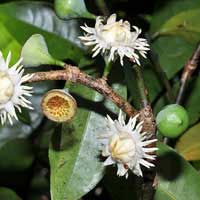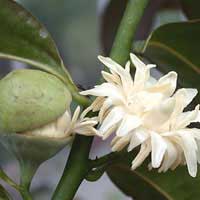Fruits Home
 Full List of Fruits
Full List of Fruits  Bolwarra fruit
Bolwarra fruitBolwarra fruit
![]() Introduction of Bolwarra fruit
Introduction of Bolwarra fruit
Scientific name - Eupomatia laurina
The Bolwarra has an internal appearance similar to that of the Guava fruit. The urn shaped fruits bear a green color on the external side and measures about 15 to 20mm in diameter. Once they ripen, the color turns yellow revealing a pale colored jelly like flesh on the inside. The seeds are spread across the flesh giving it that guava like appearance.
Bolwarra fruit is a type of native Australian fruit that is found in the Bolwarra rainforests of New South Wales. It is a small, round, and tart fruit that is yellow in color. The fruit has a sweet and sour flavor, making it a popular addition to jams and other desserts. Bolwarra fruit is also high in antioxidants and is known for its anti-inflammatory and digestive properties. Additionally, the fruit is known to be rich in vitamins A, B, and C and is a great source of dietary fiber.
![]() Nutritional Value of Bolwarra fruit
Nutritional Value of Bolwarra fruit
he bolwara fruit is rich in Vitamin C, as well as other vitamins and minerals. It is also a good source of dietary fiber and contains a variety of antioxidants. The bolwara fruit is known for its sweet, tart flavor and has a slightly crunchy texture. It is often used in salads, soups, and curries.
| Principle | Nutrient Value | Percentage of RDA |
|---|---|---|
| Energy | 97 Kcal | 5% |
| Carbohydrates | 23.38 g | 18% |
| Protein | 2.20 g | 4% |
| Total Fat | 0.70 g | 3% |
| Cholesterol | 0 mg | 0% |
| Dietary Fiber | 10.40 g | 27% |
| Vitamins | ||
| Folates | 14g | 3% |
| Niacin | 1.500 mg | 9% |
| Pyridoxine | 0.100 mg | 8% |
| Riboflavin | 0.130 mg | 10% |
| Thiamin | 0.00 mg | 0% |
| Vitamin A | 1274 IU | 43% |
| Vitamin C | 30 mg | 50% |
| Vitamin E | 0.02g | <1% |
| Vitamin K | 0.7 mg | 0.5% |
| Electrolytes | ||
| Sodium | 0 mg | 0% |
| Potassium | 348 mg | 7% |
Bolwarra can be used in many ways in the kitchen. It can be used to make jams, chutneys, sauces, and other condiments. It can also be used to make smoothies, desserts
This fruit is mostly used in cooking as a spice. Other uses in the kitchen include jams, jellies, beverages and deserts. Regeneration using cutting is not recommended. Fresh seeds if planted germinate within three weeks and take about five weeks to fully germinate and complete the process.
One of the most impressive benefits of Bolwarra fruit is its high levels of Vitamin C. Vitamin C is an essential nutrient that helps to keep the immune system strong, reduces inflammation, and aids in wound healing. It can also help to reduce the risk of developing chronic diseases such as heart disease and cancer. In addition, Vitamin C is also known to help improve skin health and reduce the appearance of wrinkles.
Bolwarra fruit is also rich in Vitamin A, which is important for healthy vision, skin health, and cell growth. Additionally, it contains a variety of minerals such as calcium, magnesium, and potassium which are essential for strong bones and teeth.
The antioxidants found in Bolwarra fruit have been shown to help reduce the risk of certain types of cancer, as well as reduce inflammation. Antioxidants are also thought to reduce the risk of heart disease and stroke.
Finally, Bolwarra fruit is high in fiber, which can help to promote digestive health and reduce the risk of obesity. Fiber can also help lower cholesterol levels and reduce the risk of Type 2 diabetes.
In conclusion, Bolwarra fruit is a nutrient-rich superfood that can provide numerous health benefits. It is high in vitamins, minerals, and antioxidants, and is a great addition to any diet. Eating Bolwarra fruit regularly can help to improve overall health and reduce the risk of developing certain diseases.
![]() Health Benefits of Bolwarra fruit
Health Benefits of Bolwarra fruit
The antioxidants found in bolwarra fruit can help to protect the body from damage caused by free radicals, which are harmful molecules that can cause oxidative stress and contribute to the development of chronic illnesses. The antioxidants can also help to reduce inflammation, which can help to reduce the risk of certain diseases, including heart disease, cancer, and diabetes.The high levels of vitamin C in bolwarra fruit can help to boost the immune system and protect against illness. Vitamin C is also important for the production of collagen, which helps to keep skin healthy and can reduce the signs of aging. Furthermore, the high levels of iron in bolwarra fruit can help to prevent anemia and improve overall energy levels.
The bolwarra fruit is a good source of dietary fiber, which can help to promote healthy digestion and can help to reduce cholesterol levels. Fiber can also help to regulate blood sugar levels, which can be beneficial for people with diabetes. The fiber in bolwarra fruit can also help to keep you feeling fuller for longer, which can aid in weight loss.The bolwarra fruit is believed to have anti-inflammatory properties, which can help to reduce pain and swelling associated with arthritis and other joint conditions. It may also be beneficial for people with asthma, as the antioxidants and anti-inflammatory properties can help to reduce inflammation in the airways.
Propagation of bolwarra fruit is a process of growing and cultivating new plants from existing plants or trees. It can be done through a variety of ways such as seeds, cuttings, grafting, and layering. Each method of propagation has its own advantages and disadvantages and its own set of skills and techniques.
Propagation through Seeds:
Propagation through seeds is the most common and easiest method of propagating bolwarra fruit. It is a relatively cheap and efficient way to produce new plants. The process involves collecting the seed from the fruit, cleaning it, and then planting it in the soil. After a period of time, the seed will sprout and grow into a new plant. The process is straightforward, however, the success rate of seeds can vary depending on the variety of bolwarra being grown.
Propagation through Cuttings:
Propagation through cuttings is another popular method of propagating bolwarra fruit. This method involves taking healthy stems from an existing plant and cutting them into small pieces. The cuttings are then planted in the soil and should produce roots within a few weeks. This method is a bit more labor intensive than propagation through seeds and can be quite difficult for novice gardeners.
Propagation through Grafting:
Grafting is another method of propagating bolwarra fruit. It involves attaching a healthy stem from an existing plant to a rootstock of a different variety. This method requires a bit more skill and experience than the other methods and is usually used by experienced gardeners. Grafting is a great way to create new varieties of bolwarra, however, the process can be quite time-consuming and the success rate can vary.
Propagation through Layering:
Layering is a method of propagating bolwarra fruit that involves burying a stem from an existing plant in the soil and allowing it to form new roots. This method is relatively easy to do and is a great way to produce multiple plants from a single stem. The success rate of this technique can vary depending on the variety of bolwarra being grown. No matter which method you choose to use, propagating bolwarra fruit can be an enjoyable and rewarding experience. Each method has its own advantages and disadvantages and its own set of skills and techniques. With the right knowledge and patience, anyone can successfully propagate bolwarra fruit!
Bolwarra fruit is a small, yellow, oval-shaped berry native to the rainforests of Australia. It is also known as the "Bush Banana" or "Kurrajong" and is a member of the family Myrtaceae. It is an important traditional food source for Australian Aboriginal peoples, having been eaten by Indigenous Australians for centuries. The earliest known use of Bolwarra fruit dates back to the early 19th century. In 1836, explorer Thomas Mitchell wrote about his experience with the fruit, noting its sweet and tart taste. He also commented on its use by the local Aboriginal people of the area, who had been using it as a food source for generations.By the early 20th century, Bolwarra fruit had become a popular food source in Australia. In 1921, the Australian government declared it a protected species, thus allowing for its legal cultivation and sale. This protection status allowed for the growth of Bolwarra fruit plantations in Australia, as well as its export to other countries.
However, due to changes in land use, such as deforestation and the introduction of new crops, the growth of Bolwarra fruit plantations began to decline in the 1970s. As a result, Bolwarra fruit began to become harder to find. This led to a decrease in production and a decrease in demand, which caused the price of the fruit to drop significantly. Today, Bolwarra fruit is still found in the wild in Australia, and although it is not as widely available as it once was, it is still an important traditional food source for many Australian Aboriginal peoples. Bolwarra fruit is also still used in many recipes, primarily for jams, preserves, and liqueurs. It is also becoming increasingly popular in other parts of the world, due to its unique flavor and nutritional value. Overall, Bolwarra fruit is an important part of Australian history and culture, and its unique taste and nutritional value make it a valuable part of the Australian diet. Its decline in popularity in the past few decades has been largely due to changes in land use, but its production and availability are slowly increasing, allowing it to once again become a staple in the traditional cuisine of Australia.


















